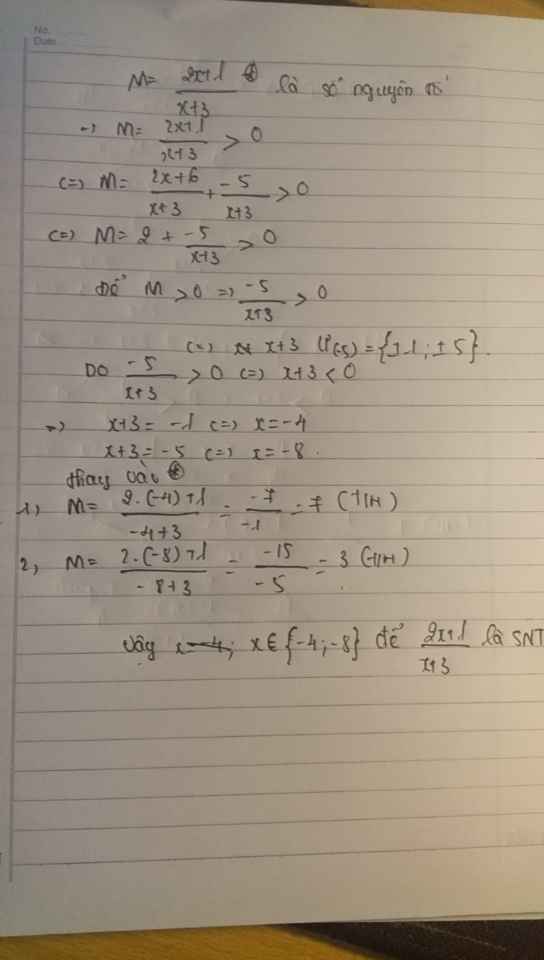Tìm \(x\in Z\) để \(\dfrac{2x-1}{x+1}\) nguyên
Hãy nhập câu hỏi của bạn vào đây, nếu là tài khoản VIP, bạn sẽ được ưu tiên trả lời.


1, để \(\dfrac{2x+1}{x+3}\) là 1 số nguyên
= > 2x + 1 chia hết cho x + 3 ( x thuộc Z và x \(\ne3\) )
= > 2 ( x + 3 ) - 5 chia hết cho x + 3
=> -5 chia hết cho x + 3
hay x + 3 thuộc Ư(-5 ) \(\in\left\{\pm1;\pm5\right\}\)
Đến đây em tự tìm các giá trị của x
2, Tương tự câu 1, x - 1 chia hết cho x + 5 ( x thuộc Z và x khác - 5 )
= > - 6 chia hết cho x + 5
= > \(x+5\in\left\{\pm1;\pm2;\pm3;\pm6\right\}\)
....
3, ( x - 1 ) ( y - 3 ) = 7
x,y thuộc Z = > x - 1 ; y - 3 thuộc Ư(7)
và ( x - 1 )( y - 3 ) = 7
( 1 ) \(\left\{{}\begin{matrix}x-1=1\\y-3=7\end{matrix}\right.\Leftrightarrow\left\{{}\begin{matrix}x=2\\y=10\end{matrix}\right.\)
(2) \(\left\{{}\begin{matrix}x-1=7\\y-3=1\end{matrix}\right.\Leftrightarrow\left\{{}\begin{matrix}x=8\\y=4\end{matrix}\right.\)
( 3) \(\left\{{}\begin{matrix}x-1=-1\\y-3=-7\end{matrix}\right.\Leftrightarrow\left\{{}\begin{matrix}x=0\\y=-4\end{matrix}\right.\)
( 4 ) \(\left\{{}\begin{matrix}x-1=-7\\y-3=-1\end{matrix}\right.\Leftrightarrow\left\{{}\begin{matrix}x=-6\\y=2\end{matrix}\right.\)
Từ ( 1 ) , ( 2 ) , ( 3 ) , ( 4 ) các cặp giá trị ( x,y ) nguyên cần tìm là ....

Để: \(\dfrac{x+3}{2x}\) ∈ Z thì:
x + 3 ⋮ 2x
=> 2. (x + 3) ⋮ 2x
=> 2x + 6 ⋮ 2x
=> 6 ⋮ 2x
=> 2x ∈ Ư (6)
=> 2x ∈ {1; -1; 2; -2; 3; -3; 6; -6}
Mà x ∈ Z => 2x ⋮ 2
=> 2x ∈ {2; -2; 6; -6}
=> x ∈ {1; -1; 3; -3}

a: Ta có: \(M=\dfrac{x^2+x}{x^2-2x+1}:\left(\dfrac{x+1}{x}-\dfrac{1}{1-x}+\dfrac{2-x^2}{x^2-x}\right)\)
\(=\dfrac{x\left(x+1\right)}{\left(x-1\right)^2}:\dfrac{x^2-1+x+2-x^2}{x\left(x-1\right)}\)
\(=\dfrac{x\left(x+1\right)}{\left(x-1\right)^2}\cdot\dfrac{x\left(x-1\right)}{x+1}\)
\(=\dfrac{x^2}{x-1}\)
b: Để M>1 thì M-1>0
\(\Leftrightarrow\dfrac{x^2-x+1}{x-1}>0\)
\(\Leftrightarrow x-1>0\)
hay x>1

Ta có : \(A=\dfrac{x^2+2x+1-4x-4+4}{x+1}\)
\(=\dfrac{\left(x+1\right)^2-4\left(x+1\right)+4}{x+1}=x+1-4+\dfrac{4}{x+1}\)
- Để A là số nguyên
\(\Leftrightarrow x+1\inƯ_{\left(4\right)}\) ( Do x là số nguyên )
\(\Leftrightarrow x+1\in\left\{1;-1;2;-2;4;-4\right\}\)
\(\Leftrightarrow x\in\left\{0;-2;1;-3;3;-5\right\}\)
Vậy ....


Bổ sung phần c và d luôn:
c, C = \(\dfrac{2}{5}\)
\(\Leftrightarrow\) \(\dfrac{x^2-1}{2x^2+3}\) = \(\dfrac{2}{5}\)
\(\Leftrightarrow\) 5(x2 - 1) = 2(2x2 + 3)
\(\Leftrightarrow\) 5x2 - 5 = 4x2 + 6
\(\Leftrightarrow\) x2 = 11
\(\Leftrightarrow\) x2 - 11 = 0
\(\Leftrightarrow\) (x - \(\sqrt{11}\))(x + \(\sqrt{11}\)) = 0
\(\Leftrightarrow\) \(\left[{}\begin{matrix}x-\sqrt{11}=0\\x+\sqrt{11}=0\end{matrix}\right.\)
\(\Leftrightarrow\) \(\left[{}\begin{matrix}x=\sqrt{11}\left(TM\right)\\x=-\sqrt{11}\left(TM\right)\end{matrix}\right.\)
d, Ta có: \(\dfrac{x^2-1}{2x^2+3}\) = \(\dfrac{x^2+\dfrac{3}{2}-\dfrac{5}{2}}{2\left(x^2+\dfrac{3}{2}\right)}\) = \(\dfrac{1}{2}\) - \(\dfrac{5}{4\left(x^2+\dfrac{3}{2}\right)}\)
C nguyên \(\Leftrightarrow\) \(\dfrac{5}{4\left(x^2+\dfrac{3}{2}\right)}\) nguyên \(\Leftrightarrow\) 5 \(⋮\) 4(x2 + \(\dfrac{3}{2}\))
\(\Leftrightarrow\) 4(x2 + \(\dfrac{3}{2}\)) \(\in\) Ư(5)
Xét các TH:
4(x2 + \(\dfrac{3}{2}\)) = 5 \(\Leftrightarrow\) x2 = \(\dfrac{-1}{4}\) \(\Leftrightarrow\) x2 + \(\dfrac{1}{4}\) = 0 (Vô nghiệm)
4(x2 + \(\dfrac{3}{2}\)) = -5 \(\Leftrightarrow\) x2 = \(\dfrac{-11}{4}\) \(\Leftrightarrow\) x2 + \(\dfrac{11}{4}\) = 0 (Vô nghiệm)
4(x2 + \(\dfrac{3}{2}\)) = 1 \(\Leftrightarrow\) x2 = \(\dfrac{-5}{4}\) \(\Leftrightarrow\) x2 + \(\dfrac{5}{4}\) = 0 (Vô nghiệm)
4(x2 + \(\dfrac{3}{2}\)) = -1 \(\Leftrightarrow\) x2 = \(\dfrac{-7}{4}\) \(\Leftrightarrow\) x2 + \(\dfrac{7}{4}\) = 0 (Vô nghiệm)
Vậy không có giá trị nào của x \(\in\) Z thỏa mãn C \(\in\) Z
Chúc bn học tốt! (Ko bt đề sai hay ko nữa :v)

\(a,\Leftrightarrow7⋮x-1\Leftrightarrow x-1\inƯ\left(7\right)=\left\{-7;-1;1;7\right\}\\ \Leftrightarrow x\in\left\{-6;0;2;8\right\}\\ b,\Leftrightarrow\dfrac{x-1+2}{x-1}\in Z\Leftrightarrow1+\dfrac{2}{x-1}\in Z\\ \Leftrightarrow2⋮x-1\Leftrightarrow x-1\inƯ\left(2\right)=\left\{-2;-1;1;2\right\}\\ \Leftrightarrow x\in\left\{-1;0;2;3\right\}\)


Ta có: 2x - 1 = 2(x + 1) - 3
Để (2x - 1)/(x + 1) nguyên thì 3 ⋮ (x + 1)
⇒ x + 1 ∈ Ư(3) = {-3; -1; 1; 3}
⇒ x ∈ {-4; -2; 0; 2}